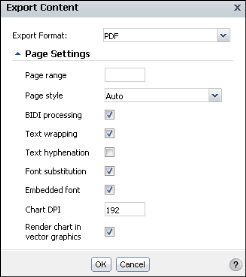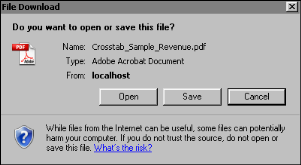Data Analyzer supports exporting content to Adobe PDF. The PDF emitter in Data Analyzer provides consistent layout and pagination properties between PDF and HTML output formats. The PDF emitter also produces a high quality PDF file with a small file size. Also, it provides high quality images for charts and SVG (scalable vector graphics) format in PDF output. The following section describes the available customization options.
Data Analyzer also supports exporting Flash charts to PDF format. When exporting Flash charts to PDF format, Data Analyzer supports embedding the exported chart in the PDF file, enabling a user to interact with it. When exported to PDF, Flash charts retain their animation properties.
To enable printing an exported Flash chart, the embedded file in the PDF document must be viewed for it to appear on the printed page. For multipage content with Flash content on several pages, view each page, so that the embedded Flash content is loaded, and then print the required pages for the Flash content to be visible in the printed output. If you do not view the pages before printing the file, the Flash content is not visible in the printed output for the pages that were not viewed.
To export all pages, leave the page range blank, which is the default setting. For multipage content, you can specify a page range or specify the page numbers to export.
When you choose Auto, the default option, Data Analyzer lays out the data such that the content fits the width of the PDF page. If the content uses headers and footers, each header and footer appears in the appropriate location. Because the PDF emitter optimizes content in terms of font and space, a single page of the content often appears on multiple pages in the PDF file. When you use the Auto option, existing pagination properties in the content are not retained in the PDF file, but the PDF output is paginated.
This option retains existing pagination properties from the original content. The font size in the printed content is often significantly smaller than in the original content, to allow the content to fit within specified page boundaries. After you send the document to a printer, further modify options on the printer dialog box as needed, so that the printed content is legible.
This option retains the existing pagination properties from the original content in the PDF output. Data Analyzer adjusts content, such as fonts and images, to fit each current content page on each page in the PDF output.
If the content contains languages that are read from left to right, such as English or French, and those that are read from right to left, such as Hebrew or Arabic, the text from both languages can be presented in the same content in the appropriate direction. This text is called bidirectional (BIDI) text. Select BIDI processing if you have content in two or more such languages and need the data to be correctly presented in the PDF or PostScript output.
Specify whether to wrap text. Selecting this option can minimize the need for horizontal scrolling to view the exported PDF.
Select this option to substitute any fonts that the application cannot interpret. Font substitution is the process of using one font in place of another when the original font is not available. The classification of fonts into families enables the process of font substitution. For example, it ensures that only a sans serif font replaces another sans serif font.
Specify the output dpi (dots per inch) for charts. To view the exported chart in higher resolution, increase the dpi value, which can result in a larger output file size. The default value is 192 dpi.
Select for existing charts in SVG (scalable vector graphic) format. This option for SVG images improves the resolution of the exported image, while maintaining a smaller file size.
|
Figure 7-1
|
|
3
|
In Page Settings, specify which of the following options to apply to the exported PDF, as shown in Figure 7-1:
|
File Download appears, as shown in Figure 7-2. Choose Open or Save.
|
Figure 7-2
|


